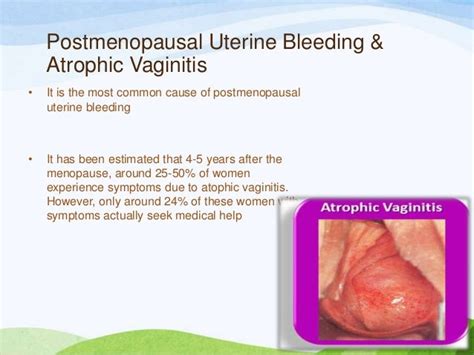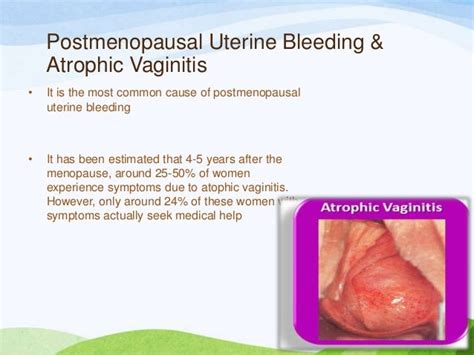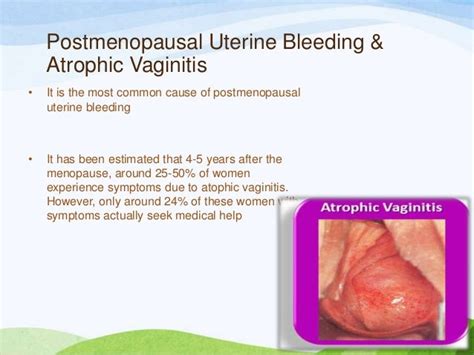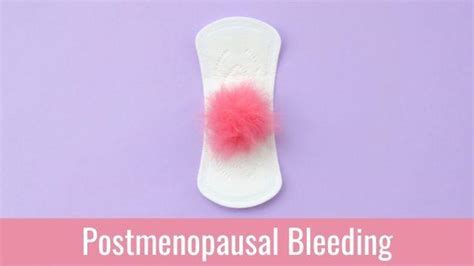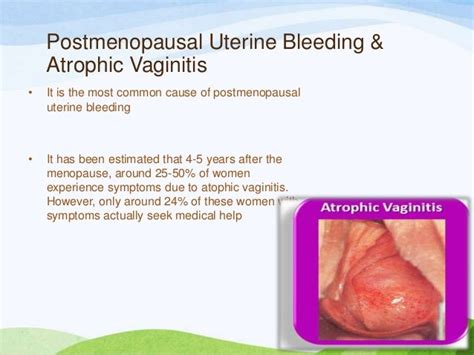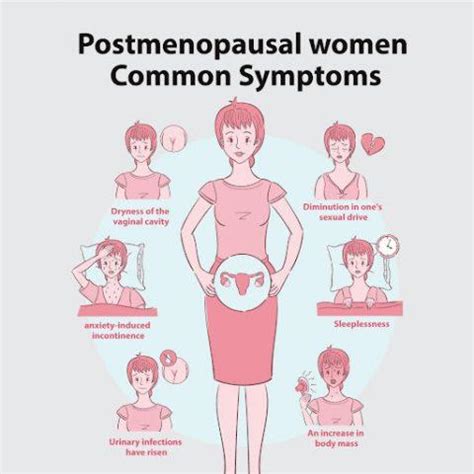Vaginal bleeding after menopause is a common concern for many women, and it's essential to understand the symptoms and potential causes. Menopause is a natural biological process that occurs in women, typically between the ages of 45 and 55, where the ovaries stop producing eggs, and hormone levels decrease. After menopause, women may experience a range of symptoms, including hot flashes, night sweats, and vaginal dryness. However, vaginal bleeding is not a typical symptom of menopause, and it can be a cause for concern.
Vaginal bleeding after menopause can be alarming, and it's crucial to seek medical attention if you experience any unusual bleeding. The symptoms of vaginal bleeding after menopause can vary, but common signs include spotting, light bleeding, or heavy bleeding. Some women may experience bleeding after intercourse, while others may notice bleeding between periods or after menopause. It's essential to track your symptoms and report them to your healthcare provider to determine the underlying cause.
The importance of understanding vaginal bleeding after menopause cannot be overstated. Vaginal bleeding can be a symptom of various conditions, some of which can be serious. For example, vaginal bleeding can be a sign of endometrial cancer, uterine cancer, or cervical cancer. Other potential causes of vaginal bleeding after menopause include hormone replacement therapy, polyps, or fibroids. By recognizing the symptoms and seeking medical attention, women can receive timely diagnosis and treatment, reducing the risk of complications.
Vaginal Bleeding After Menopause Causes
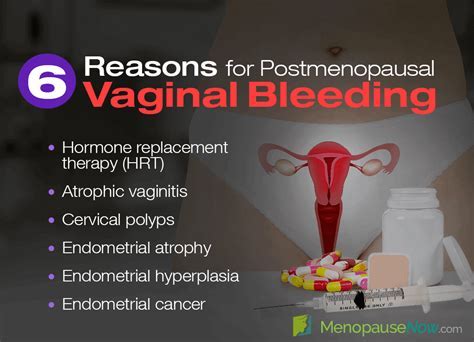
Vaginal bleeding after menopause can be caused by various factors, including hormonal changes, medical conditions, or lifestyle factors. Some common causes of vaginal bleeding after menopause include:
* Hormone replacement therapy (HRT): HRT is a treatment used to alleviate menopause symptoms, but it can also cause vaginal bleeding.
* Endometrial atrophy: This is a condition where the lining of the uterus becomes thin and fragile, leading to bleeding.
* Polyps: Polyps are growths that can develop on the cervix or uterus, causing bleeding.
* Fibroids: Fibroids are non-cancerous growths that can develop in the uterus, leading to bleeding.
* Endometrial cancer: This is a type of cancer that affects the lining of the uterus, and vaginal bleeding is a common symptom.
* Uterine cancer: This is a type of cancer that affects the uterus, and vaginal bleeding is a common symptom.
* Cervical cancer: This is a type of cancer that affects the cervix, and vaginal bleeding is a common symptom.
Vaginal Bleeding After Menopause Symptoms and Signs
The symptoms and signs of vaginal bleeding after menopause can vary, but common signs include:
* Spotting: This is light bleeding that may occur between periods or after menopause.
* Light bleeding: This is bleeding that is heavier than spotting but lighter than a regular period.
* Heavy bleeding: This is bleeding that is heavier than a regular period, and it may require changing sanitary products frequently.
* Bleeding after intercourse: This is bleeding that occurs after sexual intercourse, and it can be a sign of a underlying condition.
* Bleeding between periods: This is bleeding that occurs between periods, and it can be a sign of a underlying condition.
Vaginal Bleeding After Menopause Diagnosis
Diagnosing vaginal bleeding after menopause requires a comprehensive medical evaluation. The diagnosis process typically involves:
* Medical history: The healthcare provider will ask questions about the patient's medical history, including any previous surgeries, medical conditions, or medications.
* Physical exam: The healthcare provider will perform a physical exam to check for any signs of bleeding or other abnormalities.
* Pelvic exam: The healthcare provider will perform a pelvic exam to check for any signs of bleeding or other abnormalities.
* Imaging tests: The healthcare provider may order imaging tests, such as ultrasound or MRI, to check for any abnormalities in the uterus or cervix.
* Biopsy: The healthcare provider may perform a biopsy to check for any abnormal cells or tissues.
Vaginal Bleeding After Menopause Treatment
The treatment for vaginal bleeding after menopause depends on the underlying cause. Some common treatments include:
* Hormone replacement therapy (HRT): HRT can help alleviate menopause symptoms, including vaginal bleeding.
* Medications: Medications, such as progesterone, can help regulate hormonal imbalances and reduce bleeding.
* Surgery: Surgery may be necessary to remove any abnormal growths or tissues, such as polyps or fibroids.
* Radiation therapy: Radiation therapy may be necessary to treat cancerous cells or tissues.
* Chemotherapy: Chemotherapy may be necessary to treat cancerous cells or tissues.
Vaginal Bleeding After Menopause Prevention
Preventing vaginal bleeding after menopause requires a combination of lifestyle changes and medical interventions. Some common prevention strategies include:
* Regular check-ups: Regular check-ups with a healthcare provider can help identify any underlying conditions or abnormalities.
* Healthy diet: A healthy diet rich in fruits, vegetables, and whole grains can help regulate hormonal imbalances and reduce the risk of bleeding.
* Exercise: Regular exercise can help reduce stress and improve overall health.
* Stress management: Stress management techniques, such as meditation or yoga, can help reduce stress and improve overall health.
* Hormone replacement therapy (HRT): HRT can help alleviate menopause symptoms, including vaginal bleeding.
Vaginal Bleeding After Menopause Complications
Vaginal bleeding after menopause can lead to various complications, including:
* Anemia: Heavy bleeding can lead to anemia, a condition characterized by low red blood cell count.
* Infection: Bleeding can increase the risk of infection, particularly if the bleeding is heavy or prolonged.
* Cancer: Vaginal bleeding can be a symptom of cancer, and delayed diagnosis can lead to poor treatment outcomes.
* Infertility: Vaginal bleeding can be a symptom of underlying conditions that can affect fertility.
Vaginal Bleeding After Menopause and Pregnancy
Vaginal bleeding after menopause can be a concern for women who are pregnant or trying to conceive. Some common concerns include:
* Miscarriage: Vaginal bleeding can be a sign of miscarriage, particularly if the bleeding is heavy or prolonged.
* Ectopic pregnancy: Vaginal bleeding can be a sign of ectopic pregnancy, a condition where the embryo implants outside the uterus.
* Placenta previa: Vaginal bleeding can be a sign of placenta previa, a condition where the placenta covers the cervix.
Vaginal Bleeding After Menopause and Menopause Symptoms
Vaginal bleeding after menopause can be related to menopause symptoms, including:
* Hot flashes: Hot flashes can be a symptom of menopause, and vaginal bleeding can be a related symptom.
* Night sweats: Night sweats can be a symptom of menopause, and vaginal bleeding can be a related symptom.
* Vaginal dryness: Vaginal dryness can be a symptom of menopause, and vaginal bleeding can be a related symptom.
What are the common causes of vaginal bleeding after menopause?
+
Vaginal bleeding after menopause can be caused by various factors, including hormonal changes, medical conditions, or lifestyle factors. Some common causes include hormone replacement therapy, endometrial atrophy, polyps, fibroids, and cancer.
How is vaginal bleeding after menopause diagnosed?
+
Diagnosing vaginal bleeding after menopause requires a comprehensive medical evaluation, including medical history, physical exam, pelvic exam, imaging tests, and biopsy.
What are the treatment options for vaginal bleeding after menopause?
+
The treatment for vaginal bleeding after menopause depends on the underlying cause. Some common treatments include hormone replacement therapy, medications, surgery, radiation therapy, and chemotherapy.
In conclusion, vaginal bleeding after menopause is a common concern for many women, and it's essential to understand the symptoms and potential causes. By recognizing the symptoms and seeking medical attention, women can receive timely diagnosis and treatment, reducing the risk of complications. We encourage readers to share their experiences and ask questions in the comments section below. If you have any concerns or questions about vaginal bleeding after menopause, please don't hesitate to reach out to your healthcare provider.

